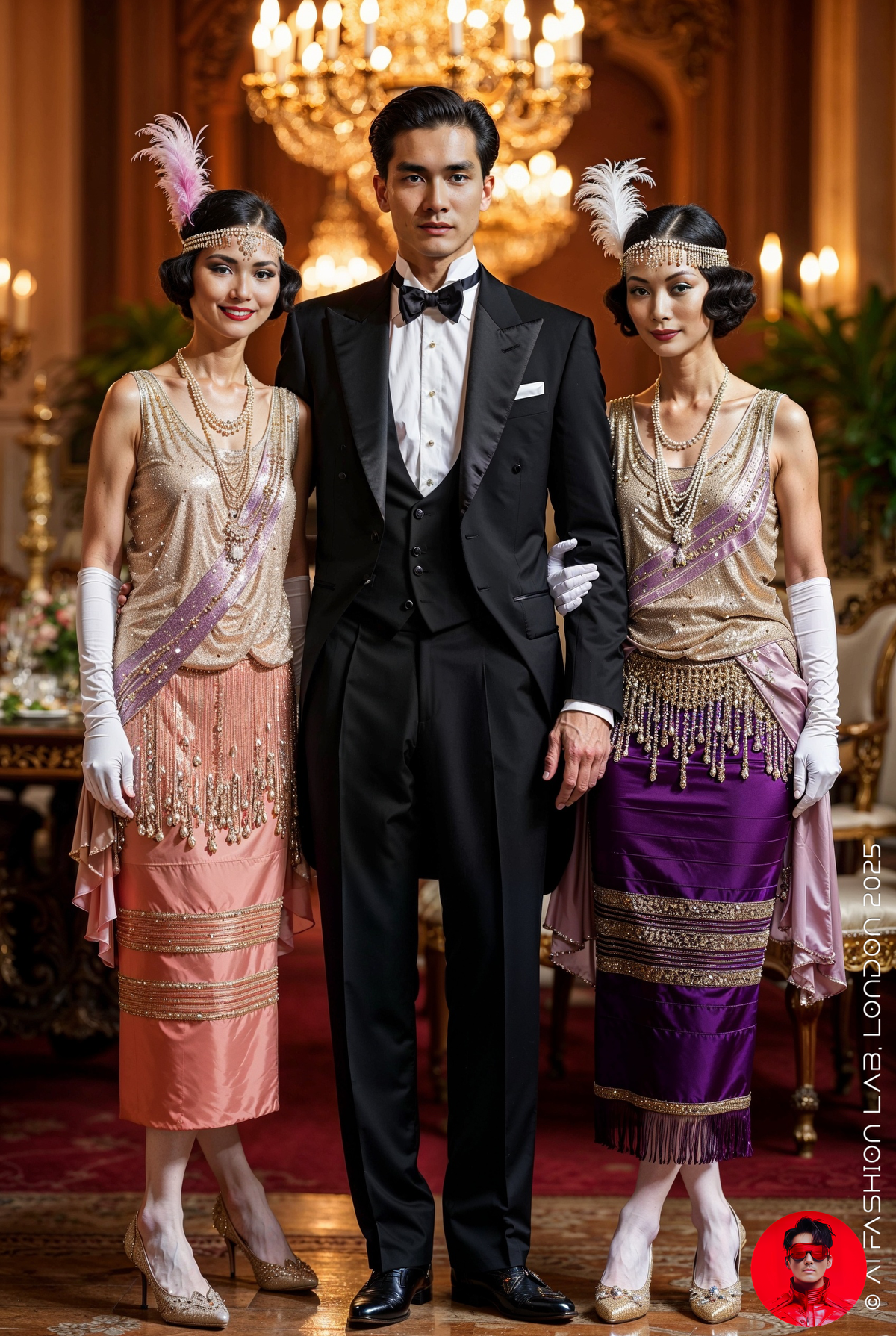พัสตราภรณ์สยามในสมัยรัชกาลที่ ๖ (ตอนที่ ๓)
พัสตราภรณ์สยามในสมัยรัชกาลที่ ๖ (ตอนที่ ๓)
จินตนาการถึงกรุงเทพฯ ในช่วงปลายรัชกาลพระบาทสมเด็จพระมงกุฎเกล้าเจ้าอยู่หัว — โลกคู่ขนานที่สังคมไทยรับเอาแฟชั่นตะวันตกมาประยุกต์ใช้ในบริบทไทยได้อย่างวิจิตรบรรจง คอลเลกชันนี้ถ่ายทอดจินตนาการนั้น ด้วยการผสานความงามของศิลปะแบบอาร์ตเดโคในยุค 1920 เข้ากับโครงร่างเสื้อผ้าแบบไทย และงานหัตถศิลป์อันประณีตงดงาม
คอลเลกชันนี้มี สองโครงร่างสำคัญ ที่โดดเด่น: โครงร่างแรกได้แรงบันดาลใจจากการแต่งกายแบบไทยดั้งเดิม คือ โครงร่างเส้นตรงคล้ายการนุ่งผ้าซิ่น ซึ่งมีรูปทรงตรง เรียบง่าย สง่างาม โดยชุดในสไตล์นี้ประดับด้วยลวดลายปักละเอียด และการปักลูกปัดวิจิตร พร้อมสายสะพายผ้าไหมที่พาดไหล่ สะท้อนความงามของการแต่งกายชั้นสูงในสังคมไทย
โครงร่างที่สองเป็นการนำเสนอ แฟชั่นตะวันตกยุค 1920 ซึ่งมีลักษณะ ชายกระโปรงบานเป็นชั้น ผ้าชีฟอง และความเคลื่อนไหวที่เป็นอิสระ แบบแฟลปเปอร์ ชุดเดรสประดับด้วยงานลูกปัดและผ้าหรูหรา ตัดเย็บอย่างวิจิตรบรรจง ถ่ายทอดบรรยากาศของความสนุกสดใสในแบบตะวันตก แต่ยังคงไว้ซึ่งความสง่างามแบบไทย
สองโครงร่างนี้ — รูปทรงผ้าซิ่นแบบเส้นตรงของไทย และเดรสแฟลปเปอร์ที่มีชีวิตชีวาของตะวันตก — ผสานกันอย่างกลมกลืน ถ่ายทอดเรื่องราวของยุคสมัยที่ไทยเปิดรับโลกสมัยใหม่โดยยังรักษารากเหง้าของตนเอง
บรรยากาศของกรุงเทพฯ ในยุค 1920 — เมืองที่กำลังตื่นตัวกับความทันสมัย แต่ยังคงรักษาเอกลักษณ์ทางวัฒนธรรมไว้ — ถูกถ่ายทอดผ่านงานออกแบบในคอลเลกชันนี้อย่างชัดเจน ชุดเดรสประดับด้วยงานปักและงานประดับลูกปัดอันวิจิตร ผสมผสานลวดลายเรขาคณิตและสีเมทาลิคแบบศิลปะแบบอาร์ตเดโคอย่างลงตัว
สำหรับเครื่องแต่งกายสุภาพบุรุษ คอลเลกชันนี้นำเสนอแฟชั่นสากลแบบ evening dress ยุค 1920 ด้วยชุดสูทแบบ white tie ประกอบด้วยเสื้อโค้ตหางยาว เสื้อกั๊กสีงาช้าง โบว์ไทสีขาว และเสื้อเชิ้ตแบบเป็นทางการ สะท้อนถึงความสง่างามของสุภาพบุรุษสยามที่เปิดรับวัฒนธรรมตะวันตกในช่วงปลายรัชกาลที่ ๖
อิทธิพลของศิลปะแบบอาร์ตเดโคในแฟชั่นสยาม
ศิลปะแบบอาร์ตเดโค ถือเป็นหนึ่งในขบวนการออกแบบที่ทรงอิทธิพลที่สุดในต้นศตวรรษที่ 20 กำเนิดขึ้นในฝรั่งเศสช่วงทศวรรษ 1910 และรุ่งเรืองสูงสุดในช่วงทศวรรษ 1920–1930 มีลักษณะเด่นคือรูปทรงเรขาคณิต ความสมมาตร และการเลือกใช้วัสดุหรูหรา อาร์ตเดโคเน้นเส้นตรง มุมแหลม และสีเมทาลิค เช่น สีทอง สีเงิน และสีคอปเปอร์ เป็นการสื่อถึงความก้าวหน้าและความงามแบบโฉบเฉี่ยวในยุคสมัยใหม่
แฟชั่นยุค 1920: ยุคใหม่แห่งความสง่างาม
แฟชั่นในทศวรรษ 1920 เป็นช่วงเวลาของการเปลี่ยนแปลงครั้งใหญ่ ผู้หญิงเริ่มละทิ้งเสื้อผ้ารัดรึงแบบเดิม หันมาใช้เสื้อผ้าที่เคลื่อนไหวได้อย่างอิสระ สไตล์แฟลปเปอร์กลายเป็นสัญลักษณ์ของยุคนี้ มีลักษณะเด่นคือ ช่วงเอวต่ำ เดรสยาวระดับเข่า และการตกแต่งหรูหรา ออกแบบโดยดีไซเนอร์ชื่อดัง เช่น Jeanne Lanvin, Coco Chanel และ Paul Poiret
ในคอลเลกชันนี้ เดรสถ่ายทอดความงามของแฟชั่นอาร์ตเดโค ด้วยงานปัก งานลูกปัด และแอปพลิเคอย่างวิจิตร เครื่องประดับ เช่น สร้อยไข่มุกเส้นยาว ที่คาดผมลูกปัดประดับขนนก ถุงมือผ้าซาติน และรองเท้าส้นสูง ล้วนเสริมให้ลุคโดยรวมสง่างามอย่างถึงขีดสุด
ไฮไลต์ของคอลเลกชัน
หนึ่งในชุดที่โดดเด่นที่สุด คือการนุ่งผ้าซิ่นตีนจกยกดิ้นทอง ต่อด้วยชายผ้าตุ้งติ้งลูกปัดทอง ใส่คู่กับเสื้อบ่าห้อยผ้าแพรยกดิ้นทอง และสร้อยไข่มุกธรรมชาติเม็ดเล็กไม่เท่ากัน รายละเอียดเล็กๆ น้อยๆ เหล่านี้ยกระดับความงดงามของเครื่องแต่งกายให้โดดเด่นยิ่งขึ้น
คอลเลกชันนี้จึงเป็นการรังสรรค์ภาพแห่งความสง่างามและจิตวิญญาณสมัยใหม่ของกรุงเทพฯ ในทศวรรษ 1920 ถ่ายทอดช่วงเวลาแห่งการเปลี่ยนผ่านที่ศิลปะแฟชั่นตะวันตกและแฟชั่นไทยโบราณผสานกันได้อย่างงดงามไร้รอยต่อ
The Fashion of Siam during the Reign of King Rama VI (Part III)
Imagine Bangkok at the end of King Vajiravudh’s reign — a parallel world where Siamese society embraced Western fashion and adapted it into a unique Thai context. This special collection envisions that alternate history, blending the glamour of 1920s Art Deco with traditional Thai silhouettes and exquisite craftsmanship.
Two distinct silhouettes define this collection.
The first draws from traditional Thai attire, featuring a tubular silhouette reminiscent of the classic phaa sin (ผ้าซิ่น)— a straight, elegant form that reflects Thai heritage through refined simplicity. Dresses in this style are richly decorated with intricate embroidery and beadwork, often complemented by delicate sashes draped across the shoulder, echoing the traditional formal wear of Siamese high society.
The second silhouette embraces Western 1920s fashion, characterised by flared hemlines, layers of chiffon, and playful movement typical of the flapper style. Dresses are adorned with elaborate beading, luxurious fabrics, and ruffled trims, creating a sense of modern dynamism while maintaining the grace appropriate to the Siamese context.
Together, these two silhouettes — the sleek, columnar Thai form and the lively Western flapper dress — present a harmonious dialogue between East and West, tradition and modernity.
The atmosphere of 1920s Bangkok — a city alive with the excitement of modernisation yet deeply respectful of its heritage — is captured vividly through these designs. Dresses are adorned with intricate embroidery, beading, and appliqué work, blending Thai textile traditions with the geometric lines and metallic accents characteristic of the Art Deco movement.
To complement the women’s ensembles, this collection also introduces gentlemen’s evening attire: classic 1920s white tie ensembles, complete with long-tail evening coats, ivory waistcoats, crisp white bow ties, and formal dress shirts. This approach reflects the refinement and dignity of Siamese gentlemen during an era when Western customs were increasingly embraced within the royal court and high society.
Art Deco Influence in Siamese Fashion
Art Deco, one of the most influential design movements of the early twentieth century, originated in France during the 1910s and reached its zenith in the 1920s and 1930s. Distinguished by its bold geometric shapes, symmetry, and luxurious materials, Art Deco celebrated modernity, technological advancement, and a sleek sense of beauty. Moving away from the flowing curves of Art Nouveau, Art Deco favoured sharp angles, metallic hues — such as gold, silver, and copper — and a sense of opulence that translated perfectly into fashion.
1920s Fashion: A New Era of Elegance
The 1920s heralded a revolution in women’s fashion. Breaking free from the restrictive garments of the previous era, women embraced clothing that allowed for greater movement and freedom. The flapper style became an iconic symbol of the decade, with lowered waistlines, knee-length dresses, and luxurious embellishments. Renowned designers like Jeanne Lanvin, Coco Chanel, and Paul Poiret popularised this new aesthetic, characterised by light, flowing fabrics and ornate decorative techniques.
In this collection, the dresses reflect the beauty of 1920s Art Deco fashion: intricate beading, delicate embroidery, and appliqué work create shimmering surfaces that catch the light with every movement. Accessories such as long pearl necklaces, beaded headbands adorned with feathers, satin gloves, and elegant heels complete the looks, adding layers of glamour and sophistication.
Highlights of the Collection
One of the most beloved pieces in this collection is a sumptuous Thai ensemble: a pha sin woven with golden threads (yok din tong), layered with golden beaded tassels, paired with a luxurious silk shoulder cloth (pha yok din tong) and a delicate strand of natural, uneven-sized pearls. These subtle details elevate the outfit, highlighting the refined craftsmanship that defines both Thai and Western influences.
This collection reimagines the elegance and modern spirit of 1920s Bangkok — a city at the crossroads of tradition and innovation. It captures a moment in history where the grandeur of Siamese culture harmoniously intertwined with the vibrant energy of Western art and fashion, creating a unique and timeless beauty.
#aifashionlab #AI #aiartist #aiart #aifashion #aifashiondesign #aifashionstyling #aifashiondesigner #fashion #fashionhistory #historyoffashion #fashionstyling #fashionphotography #digitalfashion #digitalfashiondesign #digitalcostumedesign #digitaldesign #digitalaiart #BurmeseFashionHistory #BurmeseFashionAI #flux #fluxlora





































































